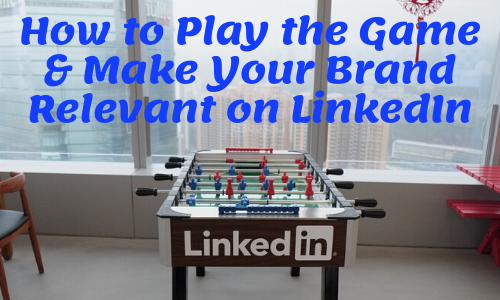
Linkedin is no longer your parent’s resume bank, it is fast becoming THE social network where you can still get noticed without having to pay your way to attention or doing something outrageous to be seen. Your posts are less likely to get lost in the noise of memes, celebrities and the latest gossip or politics that we see overwhelming other networks.
During the last two years, it seems another month does not go by without either a new feature, redesign or section relaunch happening. Whilst slow initially to adopt what other platforms have been offering for some time, the millennial and younger user expectations coupled with older users greater comfort with proactively managing their personal brands have driven Linkedin to finally come of age and provide the tools that people want. This increased level of awareness and willingness to get involved has the ‘social media gurus’ suddenly ‘discovering’ it’s benefits and telling us what we should and shouldn’t be doing.
But it is not a ‘one fits all’ situation, what works on one platform does not always translate to another. Multiple posting of content every day or being a little too personal does not carry as well on Linkedin and even prompts mini-revolts from the veterans of the network. Often you will see comments such as “this is not Facebook’ and people even rejecting or satirizing those same social media gods, something you see less of elsewhere. Even LinkedIn’s mysterious algorithm seems to favour comments over likes and shares, encouraging people to actually engage, have conversations and network, which was one of the original points when it launched a little over 15 years ago.

Some LinkedIn Stats to Consider
- 600+ million users
- Around half (300 million) of which are monthly active users
- Canada has 16 million users (7th highest country)
- 40% of those active users check in daily (120 million), by contrast, the average Facebook user is checking in 17 times A DAY!
- Only 1% (3 million) of the monthly active users post content each week.
With stats like these the strategies and approach needs to be different, add on top the fact that LinkedIn is predominantly still a business to business network and therefore a reflection of your professional brand it all makes for many ‘missing members’ being reluctant to jump back in and newbies might choose to lurk versus run the risk of making a mistake that could potentially be career-limiting or business damaging.
The good news? Linkedin is generally a forgiving place unless you are blatantly all in it for yourself, if you are able to share interesting or valuable content it is appreciated. There is not the level of anger that you tend to see elsewhere, people are supportive and encouraging. It does not have to take a lot or all of your time either because there are less activity and less content. Spending only 5-15 minutes a day is more than enough to raise your visibility and credibility as well as be seen as a valued connection.

As Ann Lamanes, Marketing Manager at Pink Elephant in Burlington offers – “Like any social media platform, LinkedIn engagement is about drawing an audience in through authentic connection. Find ways to share interesting insights about your industry. Demonstrate your thought leadership by authoring an article. Add compelling visuals for impact. There’s so much potential on LinkedIn that goes beyond liking posts or blasting your contact list with a product or service pitch”.
Where Should You Focus Your Time on Linkedin?
There are several key features and areas that you will want to focus on to gain the maximum benefit from investing your time and social capital on Linkedin;
Documents
This is the newest feature that is now available to everyone and is being boosted by the Linkedin algorithm. What that means is if you use the document posting feature you will likely get greater exposure than other forms of media or simple text posts. This is what happened when they first introduced video, so do not expect it to last forever, but for now, take full advantage.
The document should ideally be in PDF format and can be multiple pages, but do not be tempted to upload your 58-page company brochure or latest resume, as with any content it needs to offer value to the reader. Share useful insights, tips or resources. Calling them a ‘Guide’ versus ‘E-Book’ can garner a higher uptake and engagement.
Yvonne Nasri, CEO of Victory & Co in the Niagara Region, and organizer of Disrupt HR Niagara suggests, “Spend a lot of time developing content that is insightful, enjoyable to read and encourages readers to take action. Reach out or reply to the people who react, comment or share your content; it’s easy to start a conversation and when the common ground has been established it could lead to a great business relationship”
Video
You might be getting tired of hearing about the need to use video, but just take a look at what anyone under 35 is consuming (work or pleasure) and the chances are it’s on video. Don’t think it has to be Netflix quality production either, “It’s important to let go of the perfectionism when creating content because nobody can relate to it, at some point, we begin to tune out. Focus on imperfect video content that displays your personality and the raw characteristics of your brand while teaching the audience something intriguing”. advises Sandra Mijatovic, President of Donnex Mechanical in Mississauga.
The same overthinking can apply to equipment too. David Hills, Social Media Strategist from Ancaster is constantly encouraging clients to get started “We all have mobile phones that can create our own high-quality videos, while stock video clips are easily dismissed as inauthentic.”
One of LinkedIn’s primary goals is to keep you there for longer (even the CEO of Microsoft, LinkedIn’s owner, has part of his annual bonus based on this metric) so it is time to stop sharing YouTube clips or other external sources. “The reach for videos and engagement increases with organically posted videos, but don’t forget to add closed captioning” add’s Hills and that is because a high percentage of users are accessing LinkedIn at work (or the quiet zone on the train) and often the sound is turned off. If you add captioning or subtitles they will still watch.
Images
If you are not quite ready for the mini silver screen, keep that phone out and take a few photos instead. The old adage of a picture is worth a thousand words can really hold true in an environment where we are rapidly scrolling to consume information AND try and keep up. An interesting shot or location you think you recognize can make you stop.

Karol Murillo, Senior Business Development Consultant at the City of Hamilton Economic Development is a big proponent of using single and multiple images for effect, “Telling a story with beautiful pictures can really boost a business. My role is sharing Hamilton’s story. The best way to share the excitement and enthusiasm of the people building up this community is to highlight their work, whether restoring a historic building or activating an urban park. These stories hook my audience and are bringing me new enquiries and increased interest” she says.
Newsfeed
Whether it is documents, videos or images the newsfeed is where a lot of the action is on LinkedIn. As you land there though and see all the information being offered it can start to appear daunting. But there are a couple of quick actions to take that can reduce that overwhelm and ensure when you are there you are seeing content you are interested in and is relevant to you, your business or marketplace.
- #hashtags can serve you a double purpose. They are starting to be used more and be a useful way to filter content. You can follow certain ones and if you only have a minute or two to stick around you can go right to all the latest posts on that one hashtag. It is wise to also use hashtags on your own posts, but this is not Instagram so a maximum of 3 or 4 is recommended. If you have a less common hashtag you can get noticed easier and even get notified that one of your posts is trending for that hashtag, which increases your reach.
- Unfollowing people is also a helpful tactic, especially when you have those connections who follow the verbosity rule of ‘even more has to be good’. A quick click on the three grey buttons at the top right-hand corner of their post and they disappear from your newsfeed. The good news is they still remain a connection and are not notified you have decided they are not as interesting as they think they are.
Be sure to follow this advice when it comes to your own posting because it will pay dividends. As Stephanie Thompson, Engineering Leader at General Motors in St Catharines shares “When I see content for people I’m not connected to, someone in my network likes a person, or article, I get in touch with them, not just adding them to my network, I ask if we can talk on the phone. I love to hear about initiatives, and ideas they are working on, or what is going on in their space. I never know what I’m going to do with the information, or where it will lead me, but at least it’s in my back pocket of ideas!!”
Messaging
If you look to use the news feed to get noticed and then make initial interactions, once someone has become a connection move the conversation on over to 1:1 messaging. Resist the temptation to immediately blast them with links to your website or making a sales pitch. That is like meeting someone at a party and after saying hello asking them to marry you!
Instead ask what is going on in their world, what challenges they might be facing or how you can help them. “Listen and engage with your network. Engaging with your current network will help you stay in front of them and help you build relationships with them. There is no shortcut for building relationships and engagement” cautions Stacy Maynard, a LinkedIn Specialist from Oakville
Network
LinkedIn, unlike nearly all other platforms, is first and foremost a networking platform so much of the advice and principles that apply at in-person networking events can be adapted and used here. The conversation or exposure may start on LinkedIn but it can always end up somewhere else, especially when it comes to the approach of giving first.

James Burchill, CEO of James Media in Burlington and founder of Business After 5 Events provides exposure for others through ‘vehicles’ like his SmartCar Coffee Confidential video series, he notes, “This, in turn, creates reciprocity, makes me a welcome guest (pretty much everywhere) and creates an extremely positive impression in the community. Subsequently sharing guest videos on my social media channels also increases the value and my reach, and again, guests amplify this by re-sharing too. My payment? Brand awareness, sponsorship opportunities, cross-business consulting and my favourite … a growing email list to which I can market my information products”.
As with many US-centric platforms the latest features, like Live Video (still limited availability) or the LinkedIn events feature that was only running in New York and Los Angeles but is now US-wide, tend to get rolled out locally, tested, tweaked and if needed shelved before they ever see the light of day north of the border or beyond.
But that should not stop you from embracing LinkedIn as a major part of your branding and online exposure strategy as the return on time invested (and maybe a few dollars if you decide to take a premium account, although in most cases it’s not needed) can be significant and if you don’t, you can be sure your competition is.
Neil Thornton, Corporate Strategist and Owner of The Thornton Group in Niagara sums it up best; “For me and other owners I work with, the biggest theme is Your brand now precedes you. People now know everything about you before even meeting you. Personally, my 90+ written recommendations allow me to compete in a competitive marketplace. When you say it, it’s bragging; when others say it, it’s proof. For business branding and business development, LinkedIn now stands above all other platforms. Those using it are winning. Why? Because most are still not seeing the true value of it. Those not using it are simply being left behind.”
Note for Job Seekers – This article is not aimed toward the active job seekers but this recent LinkedIn article is very insightful by Matt Lovelace (and thanks to James Burchill for bringing it to my attention) – Job search notes: Relevance to the Searcher determines how profiles found by a LinkedIn People Search are sorted https://www.linkedin.com/pulse/job-search-notes-relevance-searcher-determines-how-found-lovelace/